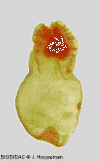The phylum Platyhelminthes contains over 20,000 animal species. Adult flatworms range in size from one millimeter to 25 meters (some tapeworms), in length. Yet, they are never more than a few millimeters thick. This is the first phylum covered that has an organ-system level of organization–a significant evolutionary advancement over the tissue level of organization. This taxon is comprised of both free-living and parasitic species.
Flatworms are bilaterally symmetrical and they have a concentration of nerve ganglia and sensory structures at one end of the body (referred to as cephalization). Bilaterial symmetry and cephalization are well suited to animals that move consistently with the anterior end forward.
Flatworms are triploblastic (having body tissues derived from three germ layers, the endoderm, mesoderm, and ectoderm). Their mesodermally derived tissues include a loose tissue called parenchyma that fills spaces between other more specialized tissues, organs, and the body wall. Depending on the species, parenchyma may provide skeletal support (remember all animals have a skeleton), nutrient storage, motility, reserves of regenerative cells, transport of materials, structural interactions with other tissues, modifiable tissue for morphogenesis, oxygen storage, and perhaps other functions yet to be determined.
The
phylum is divided into four classes: (1) the Turbellaria consist of mostly free-living flatworms (only a few are parasitic), whereas the (2)
Monogenea, (3) Trematoda, and (4) Cestoidea contain solely parasitic species.
Cladogram
|
Taenia pisiformis cysticercus stage of the tapeworm |
Phylum Platyhelminthes
1.
Usually flattened dorsoventrally,
triploblastic, acoelomate, organ-level system of organization
2.
Bilaterally symmetrical
3.
Most forms monoecious; complex reproductive
system
4.
Incomplete gut usually present; gut
absent in Cestoidea
5.
Somewhat cephalized, with an anterior
cerebral ganglion and usually longitudinal nerve cords
6.
Protonephridia as excretory/osmoregulatory
structures
7.
Unsegmented worms (members of the class
Cestoidea are strobilated) |
Return to the Invertebrate Zoology
Homepage.
